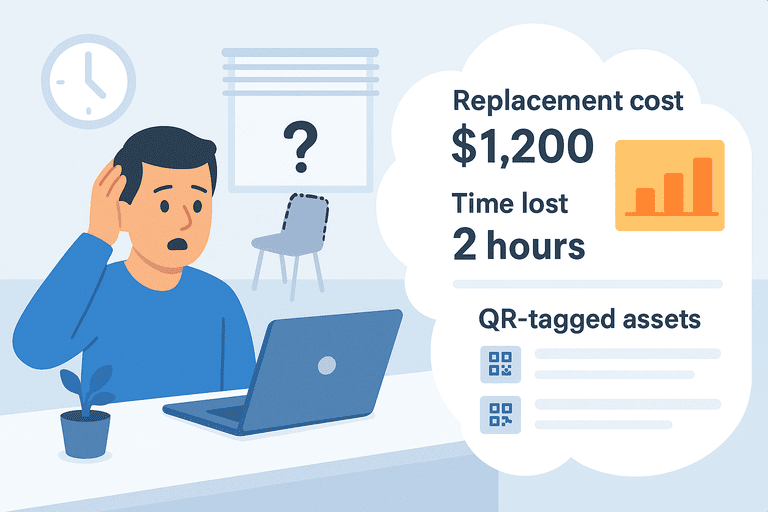Hidden Costs of Replacing Lost Office Equipment
Discover the hidden financial and operational costs of lost office equipment — and how smart tracking helps prevent them.

Introduction
When a laptop, projector, or even a simple office chair goes missing, most teams treat it as a minor inconvenience.
“Let’s just replace it,” someone says — and the conversation ends there.
But behind every “small” replacement lies a web of hidden costs — lost time, reduced productivity, and avoidable spending.
Inconsistent tracking and poor accountability quietly drain company budgets every year.
Let’s unpack the true cost of lost office equipment and how digital asset tracking can help you prevent it.
1. The Obvious Cost: Purchase Price
The easiest number to measure is the price tag of the replacement.
A laptop worth €1,000 or a monitor worth €300 might seem affordable when replaced occasionally — until it happens repeatedly.
Even small losses add up.
A 25-person office losing just two mid-range laptops a year can spend €2,000–3,000 annually on replacements.
And that’s just the beginning.
2. The Hidden Cost #1 — Lost Productivity
When equipment disappears:
- Employees waste hours searching for it.
- Work halts while waiting for a replacement.
- Shared resources (like chargers or tools) become bottlenecks.
In hybrid teams, delays compound — a missing laptop may stop a project or presentation for days.
Lost time is often more expensive than the equipment itself.
3. The Hidden Cost #2 — Administrative Overhead
Replacing an item triggers multiple small tasks:
- Reporting the loss
- Requesting approval
- Ordering and configuring new hardware
- Updating inventory and accounting records
Each step consumes time from admins, IT, and finance — often costing more in man-hours than the replacement itself.
4. The Hidden Cost #3 — Data and Security Exposure
Lost equipment often contains sensitive data or access credentials.
A misplaced USB drive or unencrypted laptop can lead to:
- Unauthorized access to company systems
- GDPR violations or compliance fines
- Damaged reputation and client trust
Data breaches are the most expensive hidden risk of all — sometimes costing millions to contain.
5. The Hidden Cost #4 — Budget Inaccuracy
Untracked losses distort financial reporting:
- Depreciation schedules become inaccurate
- Insurance coverage is under- or over-estimated
- Departments misreport usage and expenses
Over time, this erodes your ability to forecast budgets or justify new purchases.
6. The Solution — Prevent Loss Before It Happens
Smart inventory systems like InvyMate make prevention simple:
- Tag every asset with a unique QR code
- Record who’s using what and when
- Set reminders for returns or check-ins
- Run quick audits to verify presence
- Track replacements to spot patterns
When every item has digital accountability, losses drop sharply — often by 70–90% in the first year.
7. Estimating the Real Cost of Lost Equipment
Use this simple formula:
Total Loss Cost = Replacement Value + (Downtime Hours × Hourly Rate) + Admin Hours + Security Impact Estimate
For a single laptop worth €1,000:
- Downtime: 8 hours × €35/hour = €280
- Admin: 2 hours × €25/hour = €50
- Risk buffer (data/security): €150 Total = €1,480 — nearly 50% higher than the sticker price.
Conclusion
Replacing lost equipment is never just a simple purchase — it’s an operational setback with compounding costs. Every missing laptop, tool, or cable eats into time, morale, and data security.
The real savings come not from replacing faster, but from losing less.
👉 Protect your equipment — and your budget — with InvyMate. Tag, track, and manage every asset with ease before hidden costs become visible losses.